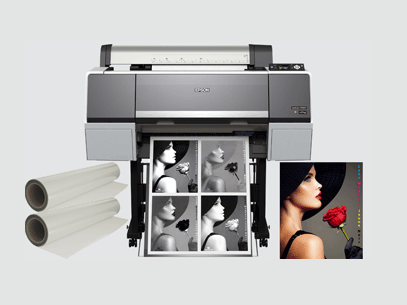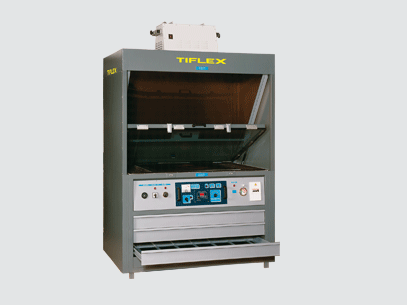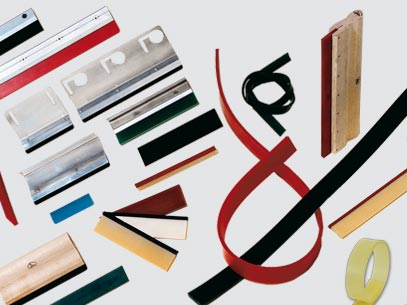
UViprim GL-BC
The two components UViprim GL-BC ink is the best choice for high speed screen printing on glass, with or without coating, for indoor use.
The main assets of UViprim GL-BC inks are their gloss, very high reactivity, chemical and dishwasher resistance. There is no need of thermic treatment.
Preparation of ink:
UViprim GL-BC is a two components UV screen printing, so add 4% of catalyst (ref. 3460565) to the ink, stir homogeneously and wait 30 min before printing.
The mixture has a pot life of 8 hours at room temperature (20-25°C). Higher temperature reduce the pot life.
Choice of the screens:
Directly function of the printing speed and the desired opacity.
Generally, one will use a 165 to 120 mesh (420-305 threads/inch) fabric tended to 16N. The diameter of the wire will be selected to obtain the best compromise between the deposit, the solidity and the definition.
Supports and pretreatments
The quality of glass and its chemical structure are related to its manufacturing method. Its surface quality will have to be perfect i.e. free from release agent or any other residue (finger marks, dust, grease, silicone etc).
Untreated glass:
A flame treatment (surface tension > 44 mN/m) according to the UVitro® process (trade mark of ISIMAT GmbH) is necessary to obtain maximum performances.
Coated glass:
Many glass containers are covered with a water or solvent-based coating to modify the surface aspect (colour, opalescent, scratch resistance…): a flame treatment, right before printing, is then essential to obtain a sufficient surface tension and thus a good adherence.
Curing conditions
All the colours can be cured under a medium pressure mercury lamp of 180-200W/cm. Optimal adhesion is achieved after 24-48H at room temperature.
The performances of the system are function of the material and the products used. Its industrial validation is imperative before final production run.
The type of reflector, UV lamps, the colours of glass, the thickness of printed ink influence the polymerization process and the adhesion of the ink.
Before printing, a pre-treatment of the glass ( flame or UVitro® or PYROSIL® ) improve the adherence of the ink.
Specifications
- Appearance: glossy
- Average density: 1,2
- Viscosity: 5 ± 1 Pa.s
- Opacifying power:
– Coloriflex system: low
– Opaque inks: excellent
– White, black: excellent - Diluents and cleaning solvents:
- Diluent: 31970NG*, 5 % maxi
- Solvents: 2891, 2899, NS-91 and NS-99
- Expiry: refer to the label
Pantone® colour matching
All the UViprim GL-BC inks, marked with an asterisk *, can be colour matched according to the Pantone® colour guide through the online Colour Matching System developped by Tiflex.
Standard colours
| Ref. 1 kg | |||
| Lemon * | 3462002 | ||
| Gold yellow * | 3462004 | ||
| Orange * | 3462006 | ||
| Scarlet * | 3462007 | ||
| Red * | 3462008 | ||
| Cyclamen * | 3462014 | ||
| Purple/Violet * | 3462016 | ||
| Blue * | 3462020 | ||
| Royal blue * | 3462028 | ||
| Green * | 3462032 |
Extra opaque
| Ref. 1 kg | |||
| Opaque white * | 3462080 | ||
| Opaque lemon | 3462082 | ||
| Opaque orange | 3462083 | ||
| Opaque red | 3462084 | ||
| Opaque green | 3462085 | ||
| Opaque black * | 3462081 |
4-Colours process
| Ref. 1 kg | |||
| 4-colours yellow | 3462050 | ||
| 4-colours magenta | 3462052 | ||
| 4-colours cyan | 3462054 | ||
| 4-colours black | 3462056 |
Base
| Ref. 1 kg | |
| Thinner base * | 3462066 |
Additives
| Ref. | |
| Catalyst, 100 g | 3524066 |
| Catalyst, 1 kg | 3524095 |
| New generation catalyst, 100 g | 3460565 |
| Opalescent varnish, 1 kg | 3462068 |
| Etching varnish, 1 kg | 3462069 |
| Window varnish, 1 kg | 3462067 |
| Photoinitiator, 100 g | 38C0595 |
| Gelling agent, 1 kg | 3952061 |
| Thickener powder, 1 kg | 3761295 |
The recommendations for use provided are based on our current knowledge, are given for instructive purposes and are entirely objective. However, as your conditions of use are out of our control, this information would not imply any guarantee on our part. They do not exempt you from carrying out prior tests in order to determine the compatibility of our inks with your printing media within your application conditions. Our responsibility, if it were to be employed, would be limited to the market value of the products that we delivered to you and that you use.






